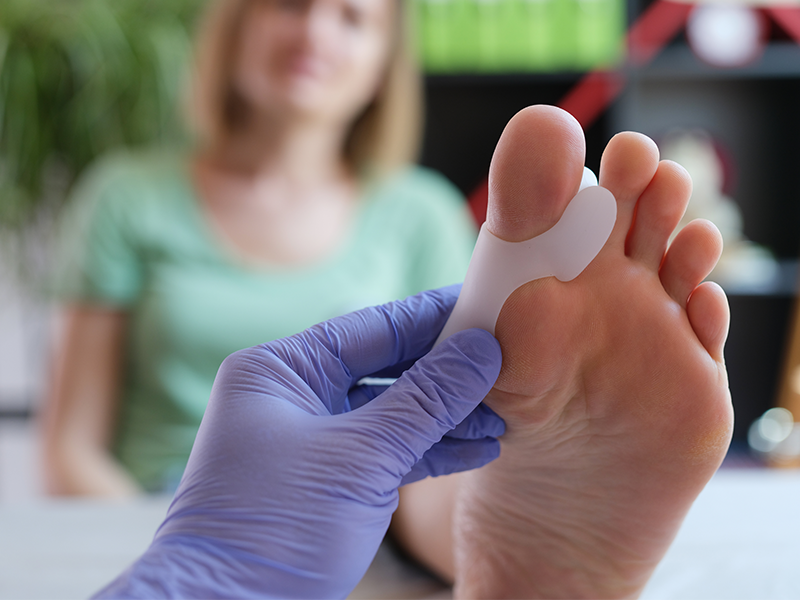Search
Find a Physician
Blog
Jun 27, 2023
When there are unbalanced forces on the foot and great toe, usually caused by a foot injury, rheumatoid arthritis, or improper footwear, your big or “great” toe may start deviating toward your other toes. This causes a bony bump to appear near the base of the great or small toe. The name of this condition is hallux valgus, but it iscolloquially referred to as bunions.
While wearing comfortable shoes and orthotic shoe inserts may help alleviate the symptoms, however these conservative methods won’t always give the desired effect. In this scenario, bunion correction surgery will be the only way. Here’s what you need to know about this surgical procedure and bunions in general.
Bones and joints in our feet are more delicate than they appear, and they only work properly when they have a great alignment. The problem is that this may notalways be the case. There are many reasons why bunions form:
The biggest problem with bunions is that they cause pain and limit the mobility of your big toe. They may also make it difficult to wear some shoes (because they cause a slight foot deformity).
The symptoms of bunions are hard to miss, and after a while, it will become quite easy to self-diagnose. You’ll notice a:
Bunions will usually worsen over time, and while wearing better footwear may alleviate the discomfort, bunion surgery is the only way to truly correct them.
First, it’s important to mention that, even if they make the situation slightly better, these methods don’t completely eliminate bunions. Still, some of the methods that might help you are:
Still, you simply can’t skip discussing bunion correction surgery when looking at how to correct bunions.
The key thing to remember is that bunion correction surgery is an umbrella term that can be used for four different procedures. You have:
Each of these surgeries takes a different approach to the same problem, meaning you need a professional to diagnose the problem. Also, the approach is often determined by the severity of the situation. Bunionectomy is the most common, followed by osteotomy bunion surgery. So, when we say bunion surgery, it’s usually these two that we’re referring to.
This is the question that most people suffering from bunions want to know. Going to surgery is never an easy decision, so how do you know if you need bunion surgery and if this will make things better?
The answer is simple. You should consider bunion surgery if:
It’s really hard to quantify the quality-of-life improvement from bunion surgery. However, according to some surveys, about 95% of patients would recommend it to friends and family after six months. In other words, the procedure does live up to the expectations.
Just remember that every situation is different and that the conditions and the level of deformity may also play a role in this.
In terms of pain levels, the surgery is performed under anesthesia. In other words, you won’t feel anything during the procedure, but you might feel some pain or discomfort after the procedure.
Often used in these types of surgeries is a regional block - where the anesthesiologist or surgeon - injects numbing medication around the nerves of the leg which supple the surgical site. These medications often last for 12 - 36 hours.
While it’s hard to quantify pain, most people find that they could have handled it with over-the-counter pain relievers that they’ve received after the surgery.
You may return to normal activities and wear regular shoes in 6-12 weeks. The thing is that this also depends on the level of deformity before the procedure, as well as the bunion correction surgery type that you’ve just undergone.
The initial stage of recovery 2-4 weeks after the surgery is vital. You need to stay off that foot as much as possible during this period. If necessary, you should even use crutches. Some patients even can get a steerable knee scooter covered by their insurance company.
Now, post-surgery, you also need to learn a thing or two about proper bunion self-care. Just because you’ve “fixed” the issue, this doesn’t mean that it could never happen to you again. Just learn how to choose proper footwear, relieve the stress on your feet by reducing your body weight, and start using some toe spacers or separators regularly. None of these is easy, but if you’re predisposed to developing bunions, it’s important that you follow this advice.
While many ways exist to alleviate pain, surgery is the only way to completely eliminate bunions. So, if you believe you can’t take it anymore and your doctor suggests surgery, it might be the best solution. Ultimately, even if you have a successful bunion correction surgery, you must always remain on the lookout. Otherwise, you’ll be back where you’ve started in no time.
Find a bunion surgeon at the Orthopedic Institute of New Jersey to learn more.
This article was reviewed and approved by an orthopedic surgeon as we place a high premium on accuracy for our patients and potential patients.